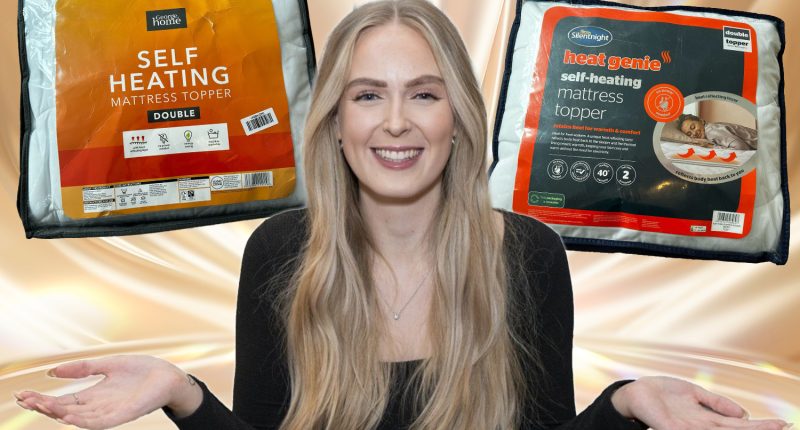THE cold nights seem to be sticking around and self-heating mattress toppers are a great energy-saving way to keep warm.
While other gadgets like electric blankets and throws cost cash to use, the toppers are completely free to run.
That’s because they work by reflecting your body heat back at you, this is done through a layer of foil within the topper.
The leading and most popular brand option on shelves tends to be Silentnight’s Heat Genie Self-Heating Mattress Topper.
It has rave reviews online and is recommended by shoppers as a bargain alternative to putting the heating on.
But it comes with quite a hefty price tag costing £45 for a double-size at Argos.
READ MORE IN MONEY
Luckily though other chains such as Asda have their own version of the nifty gadget.
Asda’s Self Heating Mattress Topper costs just £30 for a double, but how does it compare to the big-brand alternative?
We put the two toppers to the test and compared them based on quality and heating ability.
I hadn’t tried one of the gadgets before so was intrigued to see how they lived up to the hype.
Most read in Money
Of course, it’s important to bear in mind that there can be a hefty upfront cost.
But when taking into account the savings on your energy bills they could be a pretty savvy investment.
I rated them out of 10 for both quality and efficiency, giving each a combined total out of 20.
Silentnight’s Heat Genie Self-Heating Mattress Topper
- Price: £45 – Argos
Silentnight’s topper was easy to fit on my standard double bed, it’s designed like a standard fabric topper with elastic straps that fit around the corner of your mattress.
The first thing I noticed when removing it from the packaging was how thick the material is.
Its heat-reflecting foil is combined with a thermal lining and a quilted top layer adds a 7.5 tog, making it pretty dense.
I tucked myself in and waited for it to work its magic.
It took longer than I had expected, I began feeling warm after around five minutes but after that, it was pretty consistent.
Because the topper reflects your body heat, I could feel that other areas I wasn’t lying on were much cooler.
It did take around 10 minutes to feel completely toastie.
The material itself was super soft and cosy, it felt very luxurious and is a decent topper in its own right.
- Quality: 10/10
- Efficiency: 7/10
- Total score: 17/20
Asda Self Heating Mattress Topper
- Price: £30 – Asda
Taking Asda‘s topper out of the packaging, it felt thinner than Silentnight’s as the top layer didn’t have the same density.
It went on pretty easily but needed slightly more adjusting to fit exactly.
I felt Asda’s gadget warmed up slightly quicker but the temperature was more or less the exact same.
The topper was a bit firmer and wasn’t as soft as the branded alternative, which meant it didn’t feel quite as cosy.
That being said it was definitely comfortable and would be an added layer to your bedding to give you a good night’s sleep.
- Quality: 8/10
- Efficiency: 7/10
- Total value: 15/20
Verdict
Out of the two, Silentnight’s was definitely higher quality, it was much more plush and soft.
But Asda’s gadget matches the brand in terms of efficiency, and both mattress toppers will keep you a bit more cosy while you’re sleeping.
At a £15 price difference, if you’re not as fussed about the luxury feel, it could be worth saving some cash and opting for the supermarket version.
Although, it’s worth pointing out that neither boosted my temperature by a huge amount.
If you’re really looking for something to keep you warm you might consider spending the same amount of money on an electric blanket or throw instead.
Bear in mind though that both of these two gadgets do come with a running cost, but it’s pretty low at around 3p an hour.
Or you could use a hot water bottle in conjunction with the self-heating topper, which would cause it to reflect more heat into your bed.
How to save on your energy bills
SWITCHING energy providers can sound like a hassle – but fortunately it’s pretty straight forward to change supplier – and save lots of cash.
Shop around – If you’re on an SVT deal you are likely throwing away up to £250 a year. Use a comparion site such as MoneySuperMarket.com, uSwitch or EnergyHelpline.com to see what deals are available to you.
The cheapest deals are usually found online and are fixed deals – meaning you’ll pay a fixed amount usually for 12 months.
Switch – When you’ve found one, all you have to do is contact the new supplier.
It helps to have the following information – which you can find on your bill – to hand to give the new supplier.
- Your postcode
- Name of your existing supplier
- Name of your existing deal and how much you pay
- An up-to-date meter reading
It will then notify your current supplier and begin the switch.
It should take no longer than three weeks to complete the switch and your supply won’t be interrupted in that time.
Other ways to keep warm without putting the heating on
It may be tempting to turn the heating on as temperatures drop.
Luckily, there are several other ways to keep yourself and your warm without bursting the bank, and you don’t need the central heating on.
Electric under blanket
Electric blankets are a great way to keep you warm during the colder months.
You just have to fit them on top of your mattress, plug in and wait for the heat to start emanating out.
You can get them on the cheap and they don’t cost much to run either.
There’s one currently on sale on Dunelm‘s website for £22, and the retailer says it only costs 1p to run.
That works out as just 8p for eight hours, enough for a normal night’s sleep.
Close curtains and blinds
Another handy tip uses home furnishing most of us already have in our homes.
Keeping all your curtains and blinds closed throughout the evening and the day if you can can keep the heat inside your home.
That’s because they act as a barrier between your windows and the inside of your home.
The thicker our curtains are the more they’ll stop heat from escaping, especially if you have drafty windows.
That means you’re making the most of the warmth inside the house.
Insulate walls, pipes and loft
Insulating walls, pipes and your loft can be very cost-effective.
Installing installation in these parts of your home can prevent draughts from flowing through the gaps and keep your house warm.
Most DIY stores sell foam lagging, which can be cut to fit the pipes and fixed in place with insulation tape.
Previous estimates suggest that loft insulation can save you up to £315 per year on your energy bills, so it pays for itself fast.
According to experts, it’s not too difficult to insulate it yourself – however, those who need their walls insulated are better off calling experts.
Draught-proof windows and doors
One of the most effective and easiest ways to spend less energy and save money is draught-proofing – and there are plenty of ways homeowners can do this.
In the past engineers have suggested opting for self-adhesive foam strips, which are perfect if there’s a gap between your door and the floor.
Even small areas, such as keyholes and letterboxes, can allow cold air into homes, so it’s important to get these covered too.
You can pick up two rolls on Amazon or just £1 for a metre, all you have to do is cut off the amount you need and peel off the film and stick it on where you need it.
The slightest change could make a big difference.
Plug-in mini heater
Another alternative to central heating is plugging in an electric heater.
You don’t have to fork out buying a full-sized gadget, you can opt for a mini one instead.
They obviously won’t give off as much heat, but they can be useful for keeping you warm if you’re sitting in front of the TV or working from home.
They won’t cost as much to run as a larger heater either, and they have a lower upfront cost too.
Rugs aren’t just for show
Another handy and stylish option for your home is to lie a rug down.
It’s pretty simple, as with insulating your walls and loft, rugs will help insulate from the ground up.
A rug also helps keep your feet warm if you’ve got tiles or wood flooring.
They help to keep heat in and also add sound insulation too.
You can buy area rugs from most homeware retailers.
We found one on Dunelm’s website for just £30, and you can find lots of different sizes to fit the size of your room too.
Give your oven some overtime
This one may sound a bit odd but it can help give the warmth in your home a little boost.
By simply keeping your oven door open after you’ve cooked you could warm your house.
This is something that has been recommended before by savvy savers.
It essentially means that rather than heating the inside of your oven when you’re done cooking, you can at least make the most out of the heat which has built up inside.
READ MORE SUN STORIES
What energy bill help is available?
THERE’S a number of different ways to get help paying your energy bills if you’re struggling to get by.
If you fall into debt, you can always approach your supplier to see if they can put you on a repayment plan before putting you on a prepayment meter.
This involves paying off what you owe in instalments over a set period.
If your supplier offers you a repayment plan you don’t think you can afford, speak to them again to see if you can negotiate a better deal.
Several energy firms have grant schemes available to customers struggling to cover their bills.
But eligibility criteria varies depending on the supplier and the amount you can get depends on your financial circumstances.
For example, British Gas or Scottish Gas customers struggling to pay their energy bills can get grants worth up to £1,500.
British Gas also offers help via its British Gas Energy Trust and Individuals Family Fund.
You don’t need to be a British Gas customer to apply for the second fund.
EDF, E.ON, Octopus Energy and Scottish Power all offer grants to struggling customers too.
Thousands of vulnerable households are missing out on extra help and protections by not signing up to the Priority Services Register (PSR).
The service helps support vulnerable households, such as those who are elderly or ill, and some of the perks include being given advance warning of blackouts, free gas safety checks and extra support if you’re struggling.
Get in touch with your energy firm to see if you can apply.
Meanwhile, we also tested electric blankets including Silentnight and Dunelm.
Plus, we tried bargain hot chocolate makers, and the winner costs £70 less than a big-brand favourite.
Do you have a money problem that needs sorting? Get in touch by emailing [email protected].
Plus, you can join our Sun Money Chats and Tips Facebook group to share your tips and stories.













